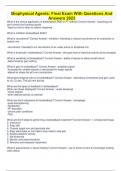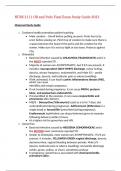Biophysical agents final - Study guides, Class notes & Summaries
Looking for the best study guides, study notes and summaries about Biophysical agents final? On this page you'll find 46 study documents about Biophysical agents final.
Page 3 out of 46 results
Sort by
Biophysical Agents: Final Exam With Questions And Answers 2023
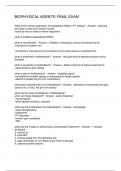
-
Biophysical Agents: Final Exam
- Exam (elaborations) • 7 pages • 2023
-
- $12.49
- + learn more
What is the clinical application of biofeedback EMG in PT setting? - Answer- -teaching pt to gain control and contract quads -teach pt how to relax to relieve migraines what is inhibition biofeedback EMG? what is recruitment? - Answer- -inhibition: intending to reduce recruitment of an overactive or spastic mm -recruitment: intended to inc recruitment of an under-active or atrophied mm what is threshold in biofeedback? - Answer- -the goal level of electrical activity set by therapis...
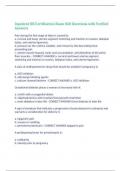
-
Inpatient OB Certification Exam 840 Questions with Verified Answers,100% CORRECT
- Exam (elaborations) • 133 pages • 2024
-
- $13.99
- + learn more
Inpatient OB Certification Exam 840 Questions with Verified Answers Pain during the first stage of labor is caused by a. cervical and lower uterine segment stretching and traction on ovaries, fallopian tubes, and uterine ligaments. b. pressure on the urethra, bladder, and rectum by the descending fetal presenting part c. uterine muscle hypoxia, lactic acid accumulation, and distention of the pelvic floor muscles. - CORRECT ANSWER a. cervical and lower uterine segment stretching and tractio...
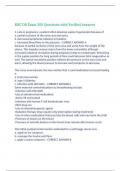
-
RNC OB Exam 300 Questions with Verified Answers,100% CORRECT
- Exam (elaborations) • 94 pages • 2024
-
- $13.49
- + learn more
RNC OB Exam 300 Questions with Verified Answers 1. Late in pregnancy, a patient often develops supine hypotension because of a. partial occlusion of the vena cava and aorta. b. decreased peripheral collateral circulation. c. increased blood flow to the placenta. - CORRECT ANSWER A because of partial occlusion of the vena cava and aorta from the weight of the uterus. This impedes venous return from the lower extremities although increased collateral circulation during pregnancy helps to...
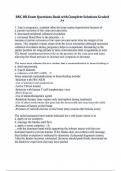
-
RNC-OB Exam Questions Bank with Complete Solutions Graded A+
- Exam (elaborations) • 86 pages • 2024
-
Available in package deal
-
- $15.00
- + learn more
1. Late in pregnancy, a patient often develops supine hypotension because of a. partial occlusion of the vena cava and aorta. b. decreased peripheral collateral circulation. c. increased blood flow to the placenta. - A because of partial occlusion of the vena cava and aorta from the weight of the uterus. This impedes venous return from the lower extremities although increased collateral circulation during pregnancy helps to compensate. Remaining in the supine position for long periods of ...

-
TEST BANK FOR RNC-OB Exam 2023/24 LATEST UPDATE
- Exam (elaborations) • 128 pages • 2023
-
- $15.49
- + learn more
TEST BANK FOR RNC-OB Exam 2023/24 LATEST UPDATE 1. Late in pregnancy, a patient often develops supine hypotension because of a. partial occlusion of the vena cava and aorta. b. decreased peripheral collateral circulation. c. increased blood flow to the placenta. - A because of partial occlusion of the vena cava and aorta from the weight of the uterus. This impedes venous return from the lower extremities although increased collateral circulation during pregnancy helps to compensate. Rema...

-
TEST BANK FOR RNC-OB Exam 2023/24 LATEST UPDATE
- Exam (elaborations) • 128 pages • 2023
-
- $15.99
- + learn more
TEST BANK FOR RNC-OB Exam 2023/24 LATEST UPDATE 1. Late in pregnancy, a patient often develops supine hypotension because of a. partial occlusion of the vena cava and aorta. b. decreased peripheral collateral circulation. c. increased blood flow to the placenta. - A because of partial occlusion of the vena cava and aorta from the weight of the uterus. This impedes venous return from the lower extremities although increased collateral circulation during pregnancy helps to compensate. Rem...
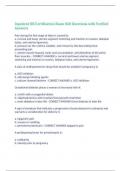
-
Inpatient OB Certification Exam 840 Questions with Verified Answers,100% CORRECT
- Exam (elaborations) • 133 pages • 2024
-
- $14.99
- + learn more
Inpatient OB Certification Exam 840 Questions with Verified Answers Pain during the first stage of labor is caused by a. cervical and lower uterine segment stretching and traction on ovaries, fallopian tubes, and uterine ligaments. b. pressure on the urethra, bladder, and rectum by the descending fetal presenting part c. uterine muscle hypoxia, lactic acid accumulation, and distention of the pelvic floor muscles. - CORRECT ANSWER a. cervical and lower uterine segment stretching and tractio...
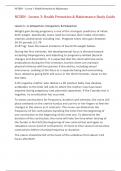
-
NCSBN - Lesson 3: Health Promotion & Maintenance Study Guide,100% CORRECT
- Exam (elaborations) • 108 pages • 2023
-
Available in package deal
-
- $15.99
- + learn more
NCSBN - Lesson 3: Health Promotion & Maintenance Study Guide Lesson 3 – A: Antepartum, Intrapartum, & Postpartum Weight gain during pregnancy is one of the strongest predictors of infant birth weight. Specifically, teens need to increase their intake of protein, vitamins and minerals including iron. Pregnant teens who gain between 26-35 pounds (11.79- 15.87 kg) have the lowest incidence of low-birth-weight babies. During the first trimester, the developmental focus is directed toward ac...

How did he do that? By selling his study resources on Stuvia. Try it yourself! Discover all about earning on Stuvia

